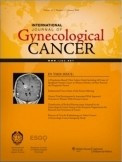Robová H, Halaška M, Pluta M, Škapa P, Strnad P, Lisý J, Rob L. Int J Gynecol Cancer. 2010 Oct;20(11 Suppl 2):S42–6. IF: 2.179

Abstract:
The role of neoadjuvant chemotherapy (NAC) in ‘bulky’ and locally advanced cervical cancer has been of interest for the last 25 years, and in many countries, NAC has become the standard of care. In the present paper, we review our 10 years' experience with high-dose-density NAC in cervical cancer management in 141 women (CervNAC I protocol). High-dose-density neoadjuvant chemotherapy and radical surgery has resulted in high clinical response rates and seems to be feasible in the management of stage IB bulky cervical cancer. Neoadjuvant chemotherapy reduces tumor volume and positivity of lymph nodes and thus minimizes the need for postoperative radiotherapy or chemoradiotherapy. Tumor size reduction and node negativity allows less radical surgical procedures such as modified radical hysterectomy or nerve-sparing radical hysterectomy. Early and especially late toxicity of our high-dose density chemotherapy is acceptable. Neoadjuvant chemotherapy followed by surgery represents a valid alternative to primary chemoradiotherapy in young and sexually active patients. Five-year survival in patients who underwent surgery in our study was 80.6 %. Currently, 3 papers with 3 approaches have been published on NAC before fertility-sparing surgery. One of the limitations of fertility-preserving surgery is deep stromal invasion and tumors larger than 2 cm. The idea underlying NAC is to reduce the size of the cervical tumor to preserve fertility. In the present paper, we also review our experience with high-dose-density NAC in fertility-sparing surgery in 15 women (LAP3-NAC protocol).
-az-
